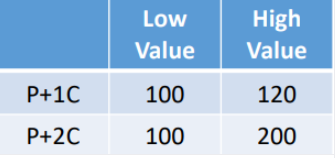Use the attached image to answer questions below. 1. Assume first that HP sells two bundles: Bundle A, containing one printer+one cartridge. Bundle B, containing one printer+two cartridges. What price should HP charge for Bundle A? 0, 80, 100, 120, 180 or 200? 2. Assume first that HP sells two bundle
This set of questions concern indirect pricing. (versioning)
Use the attached image to answer questions below.
1. Assume first that HP sells two bundles:
Bundle A, containing one printer+one cartridge.
Bundle B, containing one printer+two cartridges.
What price should HP charge for Bundle A?
0, 80, 100, 120, 180 or 200?
2.
Assume first that HP sells two bundles:
Bundle A, containing one printer+one cartridge.
Bundle B, containing one printer+two cartridges.
What price should HP charge for Bundle B?
0, 80, 100, 120, 180 or 200?
3. Assume now that HP sells the printer and cartridges separately.
Using your answers from the previous two questions:
What price should HP charge for the printer?
0,20,40,60,80 or 100?
4. Assume now that HP sells the printer and cartridges separately.
Using your answers from the previous two questions:
What price should HP charge for one cartridge?
5. In your answers above, HP prices the printer:
- Below marginal cost
- At marginal cost
- Above marginal cost
In your answers above, HP prices the cartridge:
- Below marginal cost
- At marginal cost
- Above marginal cost

Indirect Pricing:
Indirect pricing is a pricing strategy in which the price of a product or service is determined by taking into account the cost of production, overhead, and other associated costs, rather than by the market value of the product or service.
The given matrix can be interpreted as the prices for each bundle of both high and low values of the commodities.

Trending now
This is a popular solution!
Step by step
Solved in 4 steps with 1 images









